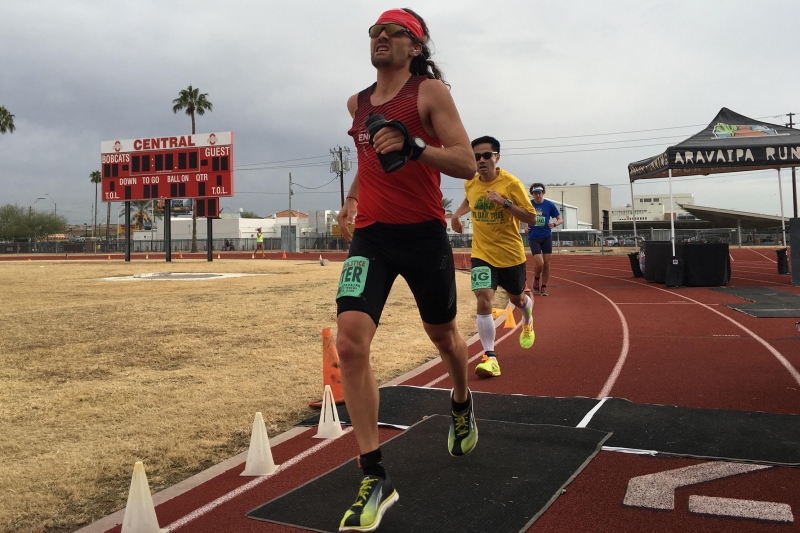HISTORY
Bitter was targeting the 11:28:03 world record, and the effort and resultant American record were years in the making.
He already had the American record, having run 11:47:21 at the 2013 Desert Solstice race. He’d also previously run ultra track races inside in Alaska, outdoors in South Carolina, and in a solo effort in California.
“I only went 57 miles in California,” he said. “I learned a lot each time, especially after this weekend.”
In a small niche of an already niche sport, Bitter is as close to a track specialist and an experienced veteran as there is.
TRAINING
“My biggest three-week set was 170, 143, and 144 miles [in consecutive weeks]. I had pretty high volume, but also a lot of specificity, a lot of progression runs, tempos. I would warm up with a 20- to 25-minute run to the track and then do a 12-mile progression run on the track at race pace, and cut the last three miles down to low 5:00 per mile pace,” he said of his go-to workout.
He did at least 90 percent of his training on the track or on a flat road, and did three to five workouts per week, mostly on a track.
The physical challenges of a long track race are unique. During the Desert Solstice race, and most other timed events, runners change direction every four hours, meaning that on Saturday Bitter ran one direction for nearly eight hours, and the other only four.
“Just that time on the track turning that much, it gets your muscles used to the turning, both directions,” Bitter said.
RACING
Few things about such a long track race are routine, including the logistics.
Compared to 2013 when Bitter first set the American record, “my bathroom breaks were more efficient,” he said. “I stopped four times in 2013, just two this time, so I only lost maybe a minute, minute and half.”
In past races, he’s added ear buds at mile 50, but this year he tuned in after just 10 miles.
“It’s just background noise,” he said, minimizing its diversion impact, but it hits at what’s so challenging about such a race. Even veteran ultrarunners can’t comprehend the mental stamina needed to run such distances on a 400-meter track.
“I’ve been working on trying to improve my state of mind so that I don’t even realize that I’m on a track,” Bitter said. He paused, and added with emphasis, “that was hard for the last 20 to 25 [miles].
“The first three quarters of the race, I’m thinking about other things, not fixating on the circles I was doing,” he said. “It’s kind of almost an out-of-body thing, like you’re watching yourself. You can do that on a track—you don’t have to think about anything but the most basic act of running. I mean, there aren’t rocks, or logs, or trees like in trail running.”
While letting his mind wander, Bitter largely stayed on pace. “Muscle memory,” he explained. “The workouts are at race pace, and especially the last few and the race-week runs. Your body just gravitates to it.
“I did have bigger lap discrepancies this year than in 2013, though, from 93 seconds to 2:00,” Bitter said. “Most [laps] were between 1:37 and 1:45, and I can do those paces pretty easily [by memory].”
As much as Bitter trained towards the track, and as much as he’s been successful, he sees opportunities for improvement. Speaking about falling just short of the world record, he said, “my muscles broke down.”

USA Records Organization_USKINGS are still collecting more information from many sources and it is our pleasure listening to everybody's comments to have a full evaluation of the USA Record story:“How Zach Bitter Broke the U.S. 100-Mile Record“
According to runnersworld.com
USA RECORDS ORGANIZATION_USKINGS



